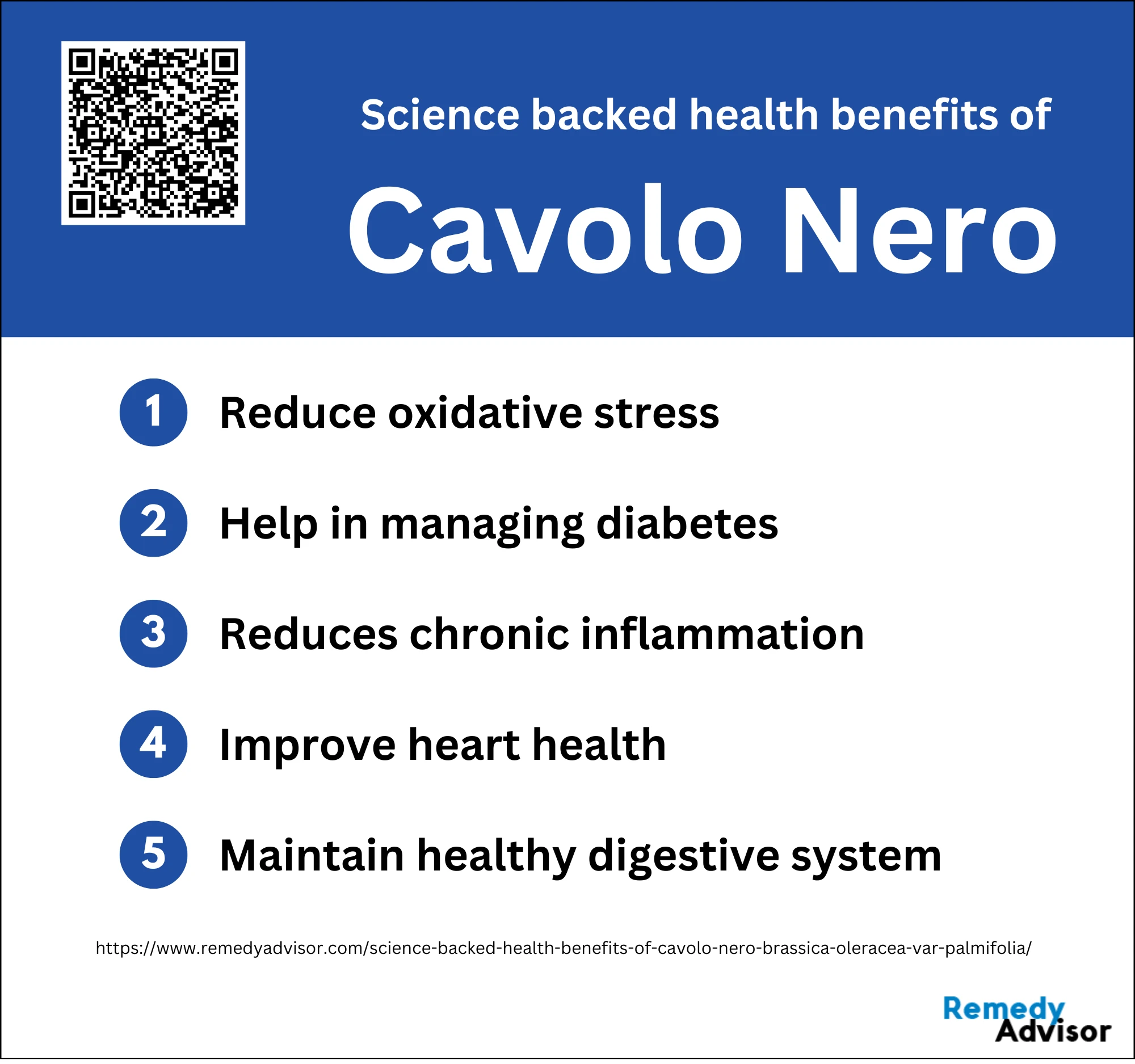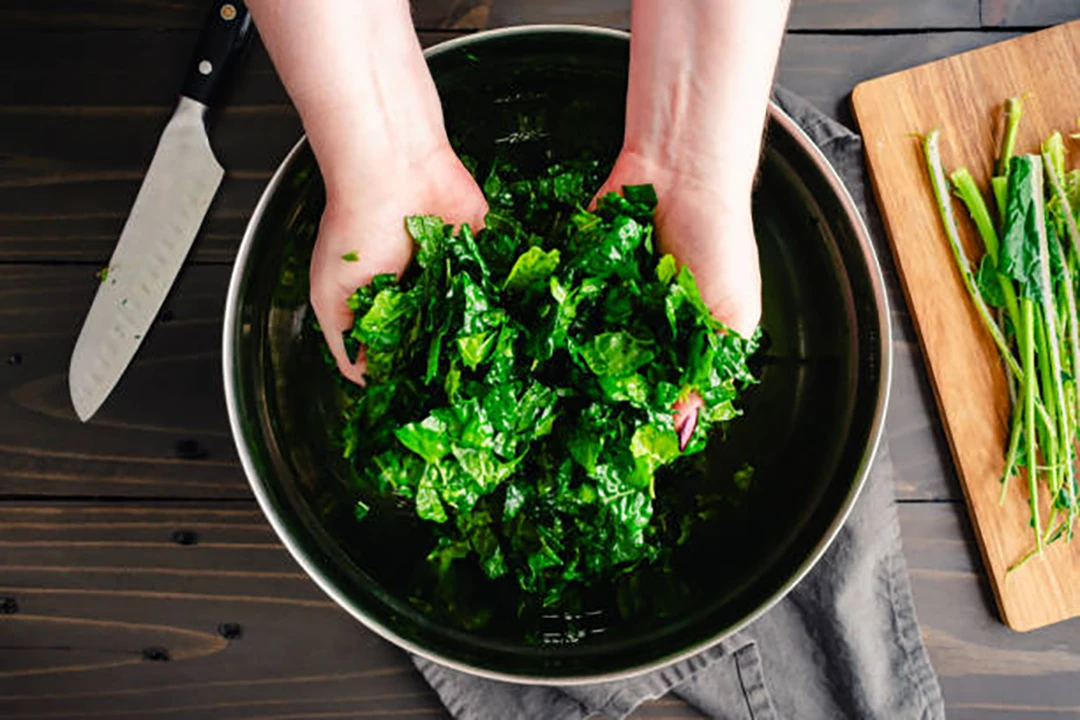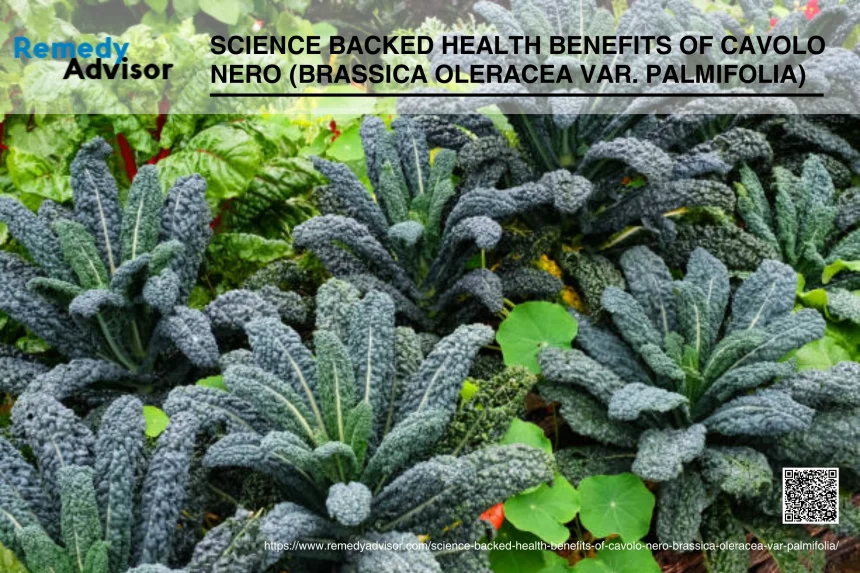Cavolo Nero, also known as Tuscan kale or dinosaur kale, is a nutrient-dense leafy green vegetable that has gained popularity in recent years due to its impressive health benefits. Scientifically classified as Brassica oleracea var. palmifolia, this dark, bumpy-leaved kale variety is part of the cruciferous vegetable family, which includes other nutritional powerhouses like broccoli, Brussels sprouts, and cabbage. Rich in vitamins, minerals, antioxidants, and bioactive compounds, Cavolo Nero offers a wide array of science-backed health benefits that make it a valuable addition to any diet. From supporting heart health and boosting the immune system to potentially reducing cancer risk and promoting bone strength, this versatile vegetable has earned its reputation as a nutritional superstar.
What is Cavolo Nero ?
Cavolo Nero is a variety of Brassica oleracea that is widely cultivated in north-central Italy. This leafy green vegetable is notable for its dark, wrinkled leaves and is often used in traditional Italian cuisine. Research has shown that Cavolo Nero possesses significant health benefits due to its rich polyphenolic composition and high antioxidant activity. Studies have demonstrated that extracts from Cavolo Nero exhibit strong enzyme inhibitory effects, particularly against cholinesterases and tyrosinase, which are enzymes linked to neurodegenerative diseases and skin pigmentation disorders, respectively. Additionally, Cavolo Nero has been found to reduce oxidative stress and lipoperoxidation in various tissues, suggesting its potential protective effects against inflammation and cellular damage. The high levels of polyphenols, such as catechin and epicatechin, along with other phenolic acids, contribute to its potent antioxidant properties. Furthermore, the antioxidant activity of Cavolo Nero varies with its growth stage, with sprouts showing the highest levels of beneficial compounds compared to microgreens and baby leaves. This makes Cavolo Nero not only a nutritious food but also a promising candidate for functional and nutraceutical applications.
Nutritional Profile of Cavolo Nero:
Cavolo Nero boasts an impressive nutritional profile, making it a powerhouse of essential nutrients. This leafy green is particularly rich in vitamins K, A, and C, with a single cup providing 178% of the recommended daily intake of vitamin K. It’s also a good source of calcium, iron, and fiber, while being low in calories. Compared to other leafy greens, Cavolo Nero stands out for its high vitamin C content, offering 32% of the daily recommended intake per serving. This nutrient density makes Cavolo Nero a valuable addition to any diet, supporting overall health and well-being.
Macro and Micronutrients:
Cavolo Nero is a nutrient-dense vegetable that offers a wide array of macro and micronutrients. It’s particularly notable for its high vitamin content, especially vitamins A, C, and K. A 30-gram serving provides 178% of the recommended daily intake for vitamin K, 32% for vitamin C, and significant amounts of vitamin A. In terms of minerals, Cavolo Nero is a good source of calcium, iron, and magnesium. It also contains a modest amount of protein and fiber, with low carbohydrate content, making it an excellent choice for various dietary needs. When compared to other leafy greens, Cavolo Nero often surpasses them in nutrient density, particularly in its vitamin C content, which is higher than that of spinach.
Phytonutrients:
Cavolo Nero is rich in phytonutrients, particularly antioxidants that offer numerous health benefits. It contains high levels of lutein, zeaxanthin, and beta-carotene, which are especially beneficial for eye health. These antioxidants help protect against age-related macular degeneration and other eye conditions. Additionally, like other cruciferous vegetables, Cavolo Nero is packed with sulphur-containing phytonutrients that support liver function and may have anti-tumor properties. The presence of these compounds, along with other flavonoids and antioxidants, contributes to Cavolo Nero’s potential in reducing inflammation, supporting heart health, and possibly even offering neuroprotective effects, though more research is needed in some areas.Top of FormBottom of Form
Science backed health benefits of Cavolo Nero
Cavolo Nero is a nutritional powerhouse that’s been gaining popularity among health enthusiasts and culinary experts alike. This dark, bumpy-leaved member of the Brassica family packs a serious punch when it comes to science-backed health benefits. From supporting heart health to boosting your immune system, Cavolo Nero (Brassica oleracea var. palmifolia) offers a wide array of advantages that make it a standout superfood. In this article, we’ll explore the compelling reasons why you should consider adding this nutrient-dense leafy green to your diet. Get ready to discover how this ancient Italian vegetable can revolutionize your health and well-being, all backed by solid scientific research.

1. Reduce oxidative stress
Cavolo Nero has been shown to possess significant antioxidant properties that can help reduce oxidative stress in the body. This leafy green vegetable is rich in various antioxidants, including lutein, zeaxanthin, and beta-carotene, which are particularly beneficial for eye health and may protect against age-related macular degeneration. Additionally, Cavolo Nero contains high levels of vitamins A, C, and K, as well as flavonoids and carotenoids, which contribute to its potent antioxidant activity. These compounds work together to neutralize free radicals and reactive oxygen species (ROS), thereby helping to maintain the balance between pro-oxidants and antioxidants in the body. Brassica vegetables, including Cavolo Nero, can have protective effects against oxidative DNA damage and may help in reducing oxidative stress-related conditions such as diabetes and hyperglycemia.
What Research Says?
- Studies indicate that cabbage extracts can suppress the production of reactive oxygen species (ROS) and reduce lipid peroxidation, thereby protecting cells from oxidative damage.
- Cabbage extracts have been found to preserve mitochondrial function under oxidative stress conditions, which is crucial for maintaining cellular energy and preventing cell death.
2. Help in managing diabetes

Cavolo Nero shows promising potential in helping manage diabetes. While specific studies on Cavolo Nero are limited, research on related Brassica vegetables suggests beneficial effects on blood glucose control. Additionally, research on broccoli (Brassica oleracea var. italica) showed protective effects against type 2 diabetes mellitus, including improvements in serum glucose levels, insulin levels, and lipid profiles. Cavolo Nero, like other Brassica vegetables, is rich in antioxidants, polyphenols, and glucosinolates, which may contribute to its potential antidiabetic properties. These compounds can help reduce oxidative stress, improve insulin sensitivity, and support overall metabolic health.
What Research Says?
- Vegetables high in bioactive compounds, such as various cabbage varieties, have shown multi-target effects on glucose homeostasis, potentially aiding in the prevention and management of T2D.
- Cabbages, including Cavolo Nero, are rich in fiber, vitamins, and minerals, which contribute to their functional properties in managing T2D. These vegetables help in reducing oxidative stress and obesity, which are underlying factors in the development of T2D.
3. Reduces chronic inflammation
This dark, leafy green vegetable is rich in antioxidants and anti-inflammatory compounds that can help combat oxidative stress and inflammation in the body. Cruciferous vegetables like Cavolo Nero contain bioactive compounds such as glucosinolates, flavonoids, and carotenoids, which possess potent anti-inflammatory properties. These phytochemicals work synergistically to modulate inflammatory pathways and suppress the production of pro-inflammatory cytokines. Cavolo Nero, has shown its ability to reduce markers of inflammation in cellular and animal models. Additionally, the high content of vitamins C and K, as well as omega-3 fatty acids in Cavolo Nero, further contributes to its anti-inflammatory effects.
What Research Says?
- Cavolo Nero extracts significantly reduce oxidative and nitrosative stress, as well as lipoperoxidation in LPS-stimulated bladder, kidney, and liver specimens. This indicates a strong inhibitory effect on inflammation and oxidative damage.
4. Improve heart health

Cavolo Nero is highly beneficial for heart health due to its rich nutrient profile and bioactive compounds. This leafy green is packed with antioxidants, including vitamins A, C, and K, which help reduce oxidative stress and inflammation, key factors in heart disease. Additionally, Cavolo Nero is a good source of potassium, which is essential for maintaining healthy blood pressure levels. It also contains fiber, which can help lower cholesterol levels by binding to bile acids and removing them from the body. Studies have shown that regular consumption of kale and other cruciferous vegetables can improve lipid profiles and reduce the risk of cardiovascular diseases by lowering bad cholesterol (LDL) and increasing good cholesterol (HDL).
What Research Says?
- Cabbage extracts, including those from Cavolo Nero, have been shown to protect against oxidative stress in cardiomyocytes by reducing reactive oxygen species (ROS) production and enhancing antioxidant protein expression. This helps in preventing mitochondrial dysfunction and apoptosis in heart cells.
- Red cabbage microgreens have been found to lower circulating low-density lipoprotein (LDL) cholesterol and hepatic cholesterol levels in mice fed a high-fat diet. This suggests that similar Brassica vegetables like Cavolo Nero may help in managing cholesterol levels and reducing cardiovascular disease (CVD) risk.
- The consumption of various Brassica vegetables, including Cavolo Nero, is associated with a reduced risk of cardiovascular diseases due to their nutrient density and bioactive compounds that support heart health.
5. Maintain healthy digestive system
Cavolo Nero is an excellent vegetable for maintaining a healthy digestive system. This leafy green is rich in dietary fiber, which is essential for proper digestion and regular bowel movements. A single cup of cooked Cavolo Nero provides about 2.6 grams of fiber, contributing significantly to the recommended daily intake. The high fiber content helps promote the growth of beneficial gut bacteria, supporting overall digestive health. Additionally, Cavolo Nero contains a type of sugar called sulfoquinovose, which specifically feeds good gut bacteria, further enhancing digestive function. The vegetable’s anti-inflammatory properties may also help soothe the digestive tract, potentially reducing the risk of digestive disorders.
What Research Says?
- Vegetable powders, including cabbage, enhance intestinal immune homeostasis and alter gut microbiota, increasing beneficial bacteria like Lactobacillus and Firmicutes while decreasing harmful ones like Bacteroides.
- Co-ingestion of red cabbage with other vegetables like cherry tomatoes enhances the bioaccessibility of anthocyanins, which are beneficial for gut health.
How to Incorporate Cavolo Nero into Your Diet
Cavolo Nero is a versatile and nutrient-packed leafy green that can easily be incorporated into a variety of dishes. Whether you’re looking to boost your intake of vitamins and minerals or simply add a new flavor to your meals, this dark, bumpy-leaved vegetable offers countless culinary possibilities. From raw salads to hearty soups, and even crispy snacks, there are numerous delicious ways to enjoy Cavolo Nero. In this article, we’ll explore some creative and tasty methods to incorporate Cavolo Nero into your diet, ensuring you reap all the health benefits this superfood has to offer.
Raw in Salads

Cavolo Nero can be a delightful addition to raw salads, bringing a robust flavor and a wealth of nutrients. To make it more palatable, it’s essential to massage the leaves with a bit of olive oil and lemon juice, which helps soften the fibers and reduce bitterness. A popular recipe includes mixing thinly sliced Cavolo Nero with walnuts, orange segments, and a balsamic vinaigrette. The combination of sweet and tangy flavors, along with the crunch of walnuts, creates a refreshing and nutritious salad perfect for any meal.
Sautéed as a Side Dish
Sautéing Cavolo Nero is a simple and delicious way to enjoy this leafy green as a side dish. Start by heating olive oil in a pan, then add chopped garlic and sauté until fragrant. Add the Cavolo Nero, season with salt, and cook until the leaves are tender and slightly crispy. For an extra burst of flavor, finish with a squeeze of lemon juice and a sprinkle of red pepper flakes. This method not only enhances the natural taste of Cavolo Nero but also makes it a versatile side that pairs well with a variety of main dishes.
Blended in Smoothies
Blending Cavolo Nero into smoothies is an excellent way to boost your nutrient intake without compromising on taste. Combine Cavolo Nero with fruits like banana and pineapple, a splash of almond milk, and a dollop of Greek yogurt for a creamy, nutrient-packed smoothie. The sweetness of the fruits balances the slightly bitter taste of the kale, making it a delicious and energizing drink to start your day. This method is perfect for those who want to incorporate more greens into their diet effortlessly.
Added to Soups and Stews
Cavolo Nero is a fantastic addition to soups and stews, where it can absorb and enhance the flavors of the broth. It works particularly well in hearty dishes like minestrone or white bean soup. Simply chop the leaves and add them to the pot during the last 10-15 minutes of cooking. The result is a nutritious, flavorful dish with the added benefits of Cavolo Nero’s vitamins and minerals. This method is not only easy but also a great way to enjoy a warm, comforting meal during colder months.
Baked into Chips
For a healthy and crunchy snack, try baking Cavolo Nero into chips. Remove the leaves from the stems, tear them into bite-sized pieces, and toss with olive oil and a pinch of salt. Spread the leaves in a single layer on a baking sheet and bake at a low temperature until they are crispy. These kale chips are a nutritious alternative to traditional potato chips and can be flavored with various seasonings like garlic powder, paprika, or nutritional yeast for an extra kick. They make for a perfect snack that is both satisfying and guilt-free.
Side effects of eating too much Cavolo Nero
Based on the search results provided, here are paragraphs on the potential side effects of eating too much Cavolo Nero:
Digestive Issues
Consuming excessive amounts of Cavolo Nero, like other cruciferous vegetables, may lead to digestive discomfort. The high fiber content in Cavolo Nero can cause bloating, gas, and constipation if eaten in large quantities, especially when consumed raw. For those with sensitive digestive systems, it’s advisable to introduce Cavolo Nero gradually into the diet and consider cooking it to reduce potential gastrointestinal issues.
Thyroid Function Interference
While moderate consumption is generally safe, excessive intake of Cavolo Nero may potentially interfere with thyroid function. Cavolo Nero contains goitrogens, compounds that can inhibit iodine uptake by the thyroid gland. This could theoretically lead to thyroid dysfunction if consumed in very large amounts over an extended period, particularly in individuals with pre-existing thyroid conditions or iodine deficiency. However, it’s important to note that cooking Cavolo Nero can significantly reduce its goitrogenic properties.
Nutrient Interactions
Overconsumption of Cavolo Nero may interfere with the absorption of certain nutrients. Its high vitamin K content could potentially interact with blood-thinning medications like warfarin. Additionally, the oxalates present in Cavolo Nero might interfere with calcium absorption if consumed in excessive amounts. For individuals prone to kidney stones, the high oxalate content in large quantities of Cavolo Nero could potentially increase the risk of stone formation.
Pesticide Exposure
While not specific to Cavolo Nero itself, there is a general concern about potential pesticide exposure when consuming large amounts of any non-organic leafy green. If Cavolo Nero is not thoroughly washed or is sourced from areas with heavy pesticide use, consuming it in large quantities could potentially lead to increased exposure to harmful chemicals. It’s always recommended to wash vegetables thoroughly and consider organic options when possible.
Conclusion
In conclusion, Cavolo Nero is a nutrient-dense leafy green that offers numerous health benefits, including reducing oxidative stress, managing diabetes, decreasing chronic inflammation, improving heart health, and maintaining a healthy digestive system. Its rich profile of vitamins, minerals, antioxidants, and phytonutrients contributes to its potent health-promoting properties. While Cavolo Nero can be easily incorporated into various dishes, from raw salads to smoothies and soups, it’s important to consume it in moderation. Excessive intake may lead to digestive issues, potential thyroid function interference, and nutrient interactions. By enjoying Cavolo Nero as part of a balanced diet, you can harness its impressive nutritional benefits while minimizing any potential side effects, making it a valuable addition to a healthy lifestyle.
ADDITIONAL RESOURCES
Here is a list of US organizations related to “research on vegetables,” along with their short descriptions and URLs:
1. The American Society for Horticultural Science (ASHS)
ASHS promotes and encourages scientific research and education in horticultural science, which includes vegetable crops.
2. University of California Agriculture and Natural Resources (UC ANR)
UC ANR conducts research and provides education on various aspects of agriculture, including vegetable production and sustainability.
Recommendations for books on Cavolo Nero
Here are some recommended books on the research of Cavolo Nero (also known as Tuscan Kale or Black Kale), along with links where you can find more information or purchase them:
1. “Brassica Crops and Wild Allies: Biology and Breeding“ by Toshiyuki Nagata, Masao Hinata, Chikako Namai
This book covers various Brassica crops, including Cavolo Nero, focusing on their biology and breeding techniques.
2. “The Complete Book of Vegetables, Herbs, and Fruits“ by Matthew Biggs, Jekka McVicar, and Bob Flowerdew
This comprehensive guide includes detailed information on growing and using a wide variety of vegetables, herbs, and fruits, including Cavolo Nero.
3. “The Vegetable Gardener’s Bible“ by Edward C. Smith
This book provides extensive information on vegetable gardening, including growing techniques for Cavolo Nero.
4. “Brassicas: Cooking the World’s Healthiest Vegetables“ by Laura B. Russell
This book explores various Brassica vegetables, including recipes and health benefits of Cavolo Nero.
5. “Kale: The Complete Guide to the World’s Most Powerful Superfood“ by Stephanie Pedersen
This book offers a comprehensive look at kale varieties, including Cavolo Nero, focusing on their nutritional benefits and culinary uses.
6. “The Kale Cookbook: Delicious and Nutritious Dishes for One of the World’s Healthiest Vegetables“ by Stephanie Pedersen
This cookbook features a variety of recipes highlighting kale, including Cavolo Nero, and emphasizes its health benefits.
7. “Vegetables: Recipes and Techniques from the World’s Premier Culinary College“ by The Culinary Institute of America
This book provides a wealth of information on cooking with vegetables, including Cavolo Nero, with recipes and techniques from professional chefs.
FAQS
- What is Cavolo Nero?
Cavolo Nero, also known as Tuscan kale, black kale, or black cabbage, is a dark leafy green vegetable from the Brassica family, closely related to kale. It has long, dark leaves and is rich in nutrients.
- What are the nutritional benefits of Cavolo Nero?
Cavolo Nero is a powerhouse of nutrients. It is rich in vitamins K, A, and C, and also provides significant amounts of B vitamins, fiber, calcium, manganese, copper, and iron. It also contains lutein and other antioxidants.
- How does Cavolo Nero support heart health?
Cavolo Nero contains antioxidants like quercetin and kaempferol, which help reduce inflammation and support heart health. Additionally, its fiber content can help lower cholesterol levels, contributing to overall cardiovascular health.
- Can Cavolo Nero help with weight management?
Yes, Cavolo Nero is low in calories but high in fiber, which can help you feel full and satisfied, making it a great addition to a weight management diet. Its low energy density means you can consume a larger volume of it without consuming many calories.
- How does Cavolo Nero benefit eye health?
Cavolo Nero is rich in lutein and zeaxanthin, antioxidants that are known to support eye health and reduce the risk of macular degeneration and cataracts.
- What role does Cavolo Nero play in bone health?
Cavolo Nero is a good source of calcium and vitamin K, both of which are essential for maintaining strong bones. Vitamin K helps in bone metabolism and works with vitamin D to support bone health.
- Can Cavolo Nero boost the immune system?
Yes, Cavolo Nero is high in vitamin C, which is crucial for a healthy immune system. Vitamin C helps in the production of white blood cells, which are essential for fighting infections.
- How does Cavolo Nero help in cancer prevention?
Cavolo Nero contains glucosinolates, which are compounds that have been linked to reducing the risk of certain cancers. These compounds help in detoxifying the body and protecting cells from DNA damage.
- Is Cavolo Nero good for digestive health?
Yes, the high fiber content in Cavolo Nero aids in digestion and helps maintain a healthy digestive system. Fiber is essential for preventing constipation and promoting regular bowel movements.
- How can I incorporate Cavolo Nero into my diet?
Cavolo Nero can be used in a variety of dishes. You can steam, bake, stir-fry, braise, boil, or microwave it. It can be added to soups, pasta, risottos, salads, or even made into crisps. It is a versatile vegetable that can enhance the flavor and nutritional value of many recipes.







